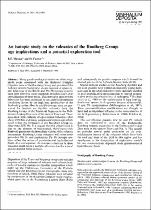 ResearchSpace
ResearchSpace
Isotopic study on the volcanics of the Rooiberg group - age implications and a potential exploration tool
JavaScript is disabled for your browser. Some features of this site may not work without it.
- ResearchSpace
- →
- Research Publications/Outputs
- →
- Journal Articles
- →
- View Item
| dc.contributor.author |
Harmer, RE

|
en_US |
| dc.contributor.author |
Farrow, D

|
en_US |
| dc.date.accessioned | 2007-03-28T07:58:50Z | en_US |
| dc.date.accessioned | 2007-06-07T10:01:50Z | |
| dc.date.available | 2007-03-28T07:58:50Z | en_US |
| dc.date.available | 2007-06-07T10:01:50Z | |
| dc.date.copyright | en_US | |
| dc.date.issued | 1995-04 | en_US |
| dc.identifier.citation | Harmer, RE and Farrow, D. 1995. Isotopic study on the volcanics of the Rooiberg group - age implications and a potential exploration tool. Mineralium Deposita, vol. 30(2), pp 188-195 | en_US |
| dc.identifier.issn | 0026-4598 | en_US |
| dc.identifier.uri | http://hdl.handle.net/10204/2137 | en_US |
| dc.identifier.uri | http://hdl.handle.net/10204/2137 | |
| dc.description.abstract | Many geochronological studies on silicic magmatic rocks associated with the Bushveld Complex (rhyolitic lavas of the Rooiberg Group and granites of the Lebowa Granite Suite) have shown evidence of open-system behaviour of the Rb-Sr and Pb-Pb isotopic systems until 1600-1000 Ma, many hundreds of million years after crystallisation of these rocks. This pervasive open-system behaviour has been attributed to sustained hydrothermal circulation driven by the high heat productivity of the Bushveld granites. New Sr and Pb isotopic data are presented for basaltic to rhyolitic volcanics from the Rooiberg Group of the Transvaal Sequence in the Dullstroom-Loskop Dam area of the eastern Transvaal. These data show little evidence of open-system behaviour after about 1950 Ma and many sample suites retain ages which could reflect the formation of the Rooiberg Group i.e. older than 2070 Ma. It is argued that this preservation is due to the absence of fractionated, fluid/vapour-rich Bushveld granites in the immediate vicinity of the volcanic occurrences. Rooiberg Group volcanics with extensively perturbed Rb-Sr and particularly Pb-Pb isotopic systems reflect the action of granite-derived hydrothermal fluids. As a consequence, the isotope systematics in these volcanics could prove a useful exploration tool for sites of granite-derived metal deposits. | en_US |
| dc.format.extent | 818083 bytes | en_US |
| dc.format.mimetype | application/pdf | en_US |
| dc.language.iso | en | en_US |
| dc.publisher | Springer Verlag | en_US |
| dc.rights | Copyright: 1995 Springer Verlag | en_US |
| dc.source | en_US | |
| dc.subject | Geochronological studies | en_US |
| dc.subject | Magnetic rocks | en_US |
| dc.subject | Volcanics | en_US |
| dc.subject | Isotopic systems | en_US |
| dc.subject | Rooiberg group | en_US |
| dc.subject | South Africa | en_US |
| dc.title | Isotopic study on the volcanics of the Rooiberg group - age implications and a potential exploration tool | en_US |
| dc.type | Article | en_US |
| dc.identifier.apacitation | Harmer, R., & Farrow, D. (1995). Isotopic study on the volcanics of the Rooiberg group - age implications and a potential exploration tool. http://hdl.handle.net/10204/2137 | en_ZA |
| dc.identifier.chicagocitation | Harmer, RE, and D Farrow "Isotopic study on the volcanics of the Rooiberg group - age implications and a potential exploration tool." (1995) http://hdl.handle.net/10204/2137 | en_ZA |
| dc.identifier.vancouvercitation | Harmer R, Farrow D. Isotopic study on the volcanics of the Rooiberg group - age implications and a potential exploration tool. 1995; http://hdl.handle.net/10204/2137. | en_ZA |
| dc.identifier.ris | TY - Article AU - Harmer, RE AU - Farrow, D AB - Many geochronological studies on silicic magmatic rocks associated with the Bushveld Complex (rhyolitic lavas of the Rooiberg Group and granites of the Lebowa Granite Suite) have shown evidence of open-system behaviour of the Rb-Sr and Pb-Pb isotopic systems until 1600-1000 Ma, many hundreds of million years after crystallisation of these rocks. This pervasive open-system behaviour has been attributed to sustained hydrothermal circulation driven by the high heat productivity of the Bushveld granites. New Sr and Pb isotopic data are presented for basaltic to rhyolitic volcanics from the Rooiberg Group of the Transvaal Sequence in the Dullstroom-Loskop Dam area of the eastern Transvaal. These data show little evidence of open-system behaviour after about 1950 Ma and many sample suites retain ages which could reflect the formation of the Rooiberg Group i.e. older than 2070 Ma. It is argued that this preservation is due to the absence of fractionated, fluid/vapour-rich Bushveld granites in the immediate vicinity of the volcanic occurrences. Rooiberg Group volcanics with extensively perturbed Rb-Sr and particularly Pb-Pb isotopic systems reflect the action of granite-derived hydrothermal fluids. As a consequence, the isotope systematics in these volcanics could prove a useful exploration tool for sites of granite-derived metal deposits. DA - 1995-04 DB - ResearchSpace DP - CSIR KW - Geochronological studies KW - Magnetic rocks KW - Volcanics KW - Isotopic systems KW - Rooiberg group KW - South Africa LK - https://researchspace.csir.co.za PY - 1995 SM - 0026-4598 T1 - Isotopic study on the volcanics of the Rooiberg group - age implications and a potential exploration tool TI - Isotopic study on the volcanics of the Rooiberg group - age implications and a potential exploration tool UR - http://hdl.handle.net/10204/2137 ER - | en_ZA |





